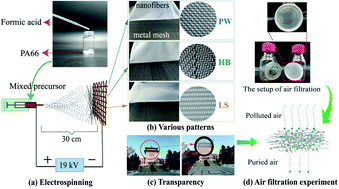Patterned nanofiber air filters with high optical transparency, robust mechanical strength, and effective PM2.5 capture capability†
Abstract
PM2.5, due to its small particle size, strong activity, ease of the attachment of toxic substances and long residence time in the atmosphere, has a great impact on human health and daily production. In this work, we have presented patterned nanofiber air filters with high optical transparency, robust mechanical strength and effective PM2.5 capture capability. Here, to fabricate a transparency air filter by a facile electrospinning method, we chose three kinds of patterned wire meshes with micro-structures as negative receiver substrates and directly electrospun polymer fibers onto the supporting meshes. Compared with randomly oriented nanofibers (named “RO NFs” in this paper) and commercially available facemasks, the patterned air filters showed great mechanical properties, and the water contact angles on their surfaces were about 122–143° (the water contact angle for RO NFs was 81°). In addition, the patterned nanofibers exhibited high porosity (>80%), and their mean pore size was about 0.5838–0.8686 μm (the mean pore size of RO NFs was 0.4374 μm). The results indicate that the transparent patterned air filters have the best PM2.5 filtration efficiency of 99.99% at a high transmittance of ∼69% under simulated haze pollution.



 Please wait while we load your content...
Please wait while we load your content...